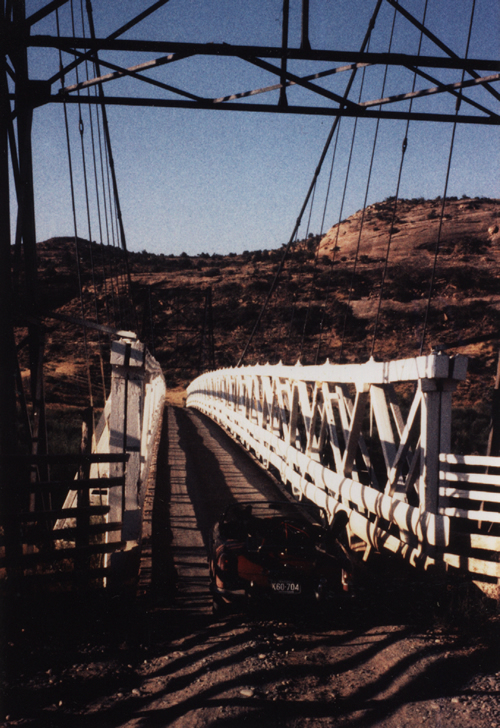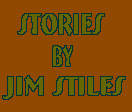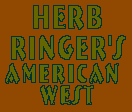

DEWEY BRIDGE: IN MEMORIAM
The death of old Dewey Bridge last month, burned to death by a seven year old playing with matches, was almost more bad news than I could bear to hear. As one relic after another of the rural West’s past vanishes, this was one remnant I thought would survive. It was just a few years ago that Jennifer Speers, the millionaire with a soul, bought up the adjacent Dewy Bridge subdivision from a developer, plowed under the roads, dismantled the infrastructure and tore down a $600,000 home in order to restore the area to the way it had been.
It was a rare place of Hope. Now this. The fire triggered memories of my first visit to Dewey, more than 30 years ago.

I first heard about Dewey Bridge, believe it or not, from my mother. In 1973, I was still living in Kentucky, trying to scrape together enough money to come West again, if only for a month or so. The previous winter, I’d passed through Moab for the first time, on one of the coldest days in recorded history. With a can of flaming Sterno on the floorboard of my VW Squareback (the damn heater never worked), I stopped only long enough to gas up and then drove all the way to Grand Junction, where I used my dad’s Gulf Oil credit card for a warm bed at the Holiday Inn.
But I’d seen enough of this country to plan a return visit under better conditions. I’d hoped to leave in July for SE Utah, but my parents had booked a raft trip down the Colorado River through the Grand Canyon with their friends, Bill and Vera Parker, and they asked me if I’d stay at their farm and keep an eye on the place. In exchange, they offered to help me out with gas money when I came West in August.
When they arrived home, I was eager to hear of their adventures on the river, and they had plenty to tell. But the highlight of their trip, it seemed, had been a 50 mile drive down a Utah back road, a dusty unpaved, corrugated "highway," designated State Route 128. And they told me of a one-lane suspension bridge, Dewey Bridge, that crossed the river 30 miles upstream from Moab.
Bill Parker was the kind of guy who’d turn down a dirt road in a Buick and never wonder if he needed high clearance or 4 wheel drive. When they exited I-70 in the middle of the Cisco desert and the pavement ended and it looked as if the route was descending into the dusty bowels of a very deep canyon, my parents thought he was crazy.
But Bill’s joyful enthusiasm and love for the canyon country was infectious. They found Dewey Bridge, tucked away safely from most of the world since 1916, paused briefly to admire the bridge and the canyon, and reached Moab by afternoon.
Weeks later, when they came home to the farm, and my dog Muckluk and I prepared to leave, my mom gave me very careful directions—it was the first exit to Cisco, not the second, she insisted. Look for the dirt road on the left, a couple miles west of the town.
I followed her directions and, incredibly, they were accurate (my mother has never been known for her navigational skills). We passed through Cisco—there was one café still open then, Ethel’s I later learned, but didn’t stop. Just as my ma had predicted, I spotted the gravel and dirt road, Utah 128, and turned left toward the river. I saw no one. Not a car or motorhome. No trucks or RVs. No ATVs. Nothing.
We came to the river, my dog and I, and figured the bridge was just ahead, but it was late afternoon, so I pulled into a stand of cottonwoods to make a camp. I pitched my cheap little blue nylon tent, fed Muck, cooked some beans on my Coleman stove and walked over to the Colorado to eat. The river was low, but the current was swift. I saw a Great Blue Heron, heard other birds whose songs I could not identify. And I could hear the rustle of the leaves in the great cottonwoods above me.
Finally, as the canyon filled with shadows, I heard the whine of a motor, coming down the grade from Cisco. It was a pickup truck, a local rancher I guessed. He saw me and waved and kept going. I could hear his truck for a few minutes and then the silence returned.
That night was one of the happiest of my life. An evening of "quiet exaltation" as someone once said.
The next morning, I found the bridge, just where my mom said it would be. We stopped for a while, Muckluk jumped in the river for a swim so she could later smell up the upholstery on my car. It was a glorious morning.
I knew it would be the first of many visits to Dewey Bridge. It never occurred to me that any of this would change or disappear.
But in 1974, much of the gravel and dirt road from Cisco to Moab was paved, though the asphalt was rough and pitted, and the "improvements" were negligible. Even better, because Dewey Bridge was only one lane wide, barely eight feet, large vehicles could not get across it. It was one kind of discrimination I could live with and even applaud. For another decade the road from Moab to Cisco remained quiet.
In 1985, however, UDOT construction began on a new bridge, just down river from the old one. And a year later, when it opened, traffic on highway 128 increased dramatically. Further "improvements" have brought still more traffic. Sometimes it is downright congested. Still, it’s a beautiful drive and those discovering it for the first time will be awestruck. But they’ll never be able to understand just what it felt like on that summer night in 1973. I’m not even sure they’d care to.
Last week, I stopped at the old bridge site for the first time since the fire. I could still smell the ash. The parking lot adjacent to it is now a staging area for mountain bicyclists and on this day, about a hundred brightly clad participants were prepping themselves and their bikes for a ride over the Kokopelli Trail. I felt peculiarly out of place in my Wranglers and Redwings—as much of an anachronism as the old bridge once was. I walked to the south abutment. The fire had burned every sliver of wood; all that remains are the cables. I stood there for several minutes, almost paralyzed by the sight.
One of the bikers walked up to me and said, "Hey I hear they might rebuild it...It’ll be just like it was before."
I looked at him, smiled, and went back to my car.
ABBEY’S FOIA
Last issue, I began printing selected documents from Edward Abbey’s FBI FOIA file. For the acronyminally challenged, FOIA means "Freedom of Information Act." In the early 80s, Abbey requested his FBI dossier and waited several months for the papers to arrive. He had high hopes of discovering things about himself even he didn’t know, but the finished product was, to Ed, mainly disappointing.
I saw Abbey one night at Arches, pulled off the road near Balanced Rock in that godawful pickup truck of his. I may be mistaken, but it seems he told me that most of the body damage occurred when he somehow missed a light pole as he was tearing ass across a shopping mall parking lot.
"Those goddamn poles are well anchored in concrete Stiles. Avoid them if you can."
He planned on camping illegally along the old entrance road and I was obliged to waive the "no roadside camping rule" in this case. He invited me to join him and we spent a better part of the evening talking about the FOIA files.
Abbey had hoped for so much more. I think he was shooting for the FBI Most Wanted List, but there was no suggestion that his rants to blow up Glen Canyon Dam, the Reagan Presidency, or the Military Industrial Complex had got him anywhere near incarceration, or even heavy surveillance.
He seemed depressed.
There were some bright moments. He had been spotted at a conference for children’s rights in Vienna in 1952—he’d in fact accidentally stumbled into it while in pursuit of a woman--- and the powers-that-be took it to mean he was a Communist.
Otherwise, the documents included heavily edited interviews with friends and colleagues who often found Abbey, "irritating and arrogant," but could find nothing truly subversive.
Abbey told me he needed to try harder.
Ed died in March 1989. A few weeks later, a massive FBI undercover operation led to the arrest of many of Earth First! leaders (EF! was Ed’s favorite enviro group). I’ve always wondered how Abbey would have dealt with all that. Had he not been arrested in the big bust, I think it might have broken his heart.
RE: ZEPHYR ‘HEALTH & WELLNESS’
For some reason, many Zephyr readers tell me they start at the back of each issue and read forward. Why they do this, I have no idea. I’d like to think they’re saving the best (this column) for last. But more likely, they’re postponing my rant as long as possible.
In any case, if you are a back-to-front reader, then you already see the irony in the image above, received just recently and which gave me a good chuckle.
But if you are the odd duck that actually begins their read here and moves up the numeric scale, then you might want to pause and check out page 31, so you can be in on the joke as well.
In any case, I’ve been searching for that Zephyr health and wellness editor for quite some time and have finally given up, on one front at least.
I’ll have a lot more to say about all this and my plans to keep The Zephyr alive online in the issues ahead. But for now, let’s pretend everything is the way it’s always been. I’ll deal with all these changes tomorrow.
HUMANS’ CLOSE CALL
Speaking of near extinction, DNA research by American and Russian scientists recently offered some startling news---humans almost didn’t make it.
According to recent DNA analysis, about 70,000 years ago, the human race may have dwindled dramatically, perhaps to as few as 2000 of us.
What caused the near extinction is unclear, but scientists speculate that a disease of some sort decimated the species, leaving but a relative handful of us clinging to survival.
Somehow, we battled back, overcame the killer disease and now populate every corner of the planet. But the mind can’t help but wonder how differently life on Earth may have evolved, had we been taken out of the formula.
And I can’t help but wonder, as I always do, just where we go next. Ponder these numbers...
In October 2006, the offical population of the United States reached 300 million. It was the cover story in this publication.
Since then our population has climbed to, as of May 18 at 4pm:
304,115,756
Another four million Americans in about 20 months. The world population on that date was:
6,668,519,876
The projected population mid-century? Nine billion.







